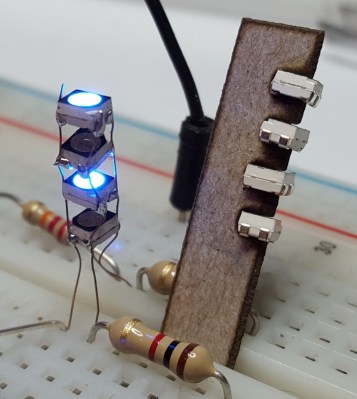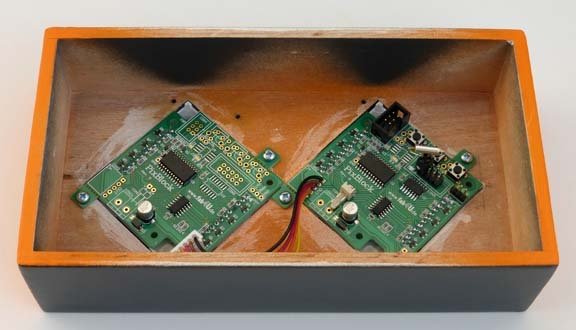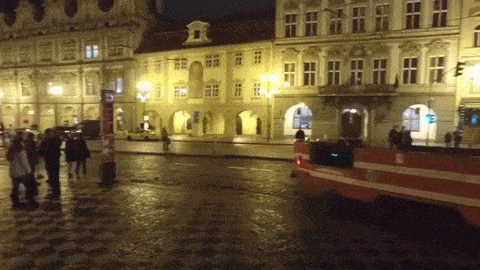There are only so many blinking light patterns you can create with a microcontroller before you get bored. [Garrett] apparently felt that way and decided to build a music-driven LED display on some LED shades. The system has three main elements: a microphone, a preamp, and a 7-band spectrum analyzer chip. You can see the results in the video below.
LED Hacks1897 Articles
Building The World’s Smallest RGB LED Cube
What’s the smallest RGB LED cube? A 1x1x1 cube is easy, but it’s a stupid joke and we’ve heard it before. No, to build the smallest LED cube, you’ll have to stuff 64 RGB LEDs into a cubic inch, like [Hari] did with his miniscule LED cube.

One might think that individually addressable RGB LEDs are the way to go with an LED cube this small. Anything else would hide the LEDs behind a mess of wires. This isn’t the case with [Hari]’s LED cube – he’s using standard surface mount RGB LEDs for this build. But how is he connecting the things?
The entire build was inspired by the a much earlier project, the Charliecube. This LED cube, like [Hari]’s uses Charlieplexing to condense all the connections for a column of LEDs to only four wires. Repeat that sixteen times, and [Hari] built himself a tiny, one-inch cube of glowey goodness.
The cube itself was built with a PCB backplane designed in Eagle and fabbed at OSHPark. The LEDs are driven by an Arduino Nano. If you’d like to build your own, or you’re a masochist for dead bug soldering, you can grab all the design files over on [Hari]’s hackaday.io project page.
Continue reading “Building The World’s Smallest RGB LED Cube”
A Vase Of Ice And Fire
When we first saw [Ginko Balboa]’s vase of ice and fire, we weren’t that impressed. Until we realized that the whole vase was a glass, copper, and solder circuit with LEDs sandwiched in between. The tutorial starts with [Ginko]’s technique for etching a custom board for the base circuit. It gets interesting with the construction of the LED circuit.
First a glass bottle was scored in a pattern and shattered, leaving a jigsaw puzzle. Two differently colored LED light strips were desoldered. Then, from the bottom up, the glass was taped around with an adhesive backed copper tape, and soldered together. Every now and then an LED was soldered between the carefully separated areas of the circuit. Some LEDs were soldered in one way, and some the other. This way the vase could be rotated on its base to select a different color. Once the outside of the vase with the LED circuit inside it was finished, another cut bottle was put in the center and soldered in a final position, making the assembly waterproof.
The final product is really interesting, and we’re scratching our head to figure out if there’s anything else this technique of circuit building could be used for. Ideas?
The Flowing Pixels Of Time Wait For No Man
The hourglass dramatically depicts the flow of time; gravity pulling grains of sand inevitably downward. So it is with the Bits of Time project by [Frank Andre]. The pixels drop, stopping only when the battery dies. Or, when your eggs are ready. (Pssst, it’s also on Hackaday.io.)

The project starts with a couple of [Frank’s] PixBlocks. A processor is added to one PixBlock to serve as the controller for both after they are connected via the serial bus. A tilt switch, with a debouncing circuit, is connected to an IO pin. This tells the processor the orientation of the box and therefore which way the pixels should flow.
Two switches set the duration of the timer in 15 second increments. A third starts the timer. When the box is rotated the pixels start flowing in the opposite direction. With code available on GitHub the system can be programmed for other effects such as changing colors, flickering, or even text display.
You’ll agree this is a bit less intimidating than the MacGyver-ish kitchen timer we covered last year.
Continue reading “The Flowing Pixels Of Time Wait For No Man”
Recursive Soldering Iron Hacking
We’ve all done it. You’re walking out the door or maybe you’ve even gotten on the road when the question hits, “Did I leave the [coffee pot | stove | hair curler | soldering iron ] on?” [Daniel Johnson’s] problem was even worse. He couldn’t tell if his Hakko-936 soldering iron was off because the LED indicator wasn’t always on. Instead it flashed. He fixed that problem and along the way hacked his battery powered soldering iron since he was out of batteries. Now that’s perseverance.

The Hakko’s LED turned on whenever the power turned on to heat the tip. That was about every 5 seconds once the tip was hot. But just as a watched pot never boils, a watched LED never seems to flash. After determining the LED was driven by a comparator he decide to unsolder it as part of his hack. He wisely decided using the Hakko on itself was not a good idea so reached for the battery-powered portable iron, which was sadly battery-free. Undaunted, he wired the portable to a power supply and when 4.5 volts didn’t melt the solder cranked it up to 6 volts.
Back to the Hakko, he replaced the red LED with a RBG LED but used only the red and green leads. The green was tied to the 24v power supply through a hefty 47k ohm resistor, and the red was tied to the comparator. A little masking tape to hold things in place and provide insulation finished the job. Now when the Hakko is on the green LED is lit and the red LED shows the heating cycle. Quite clever.
Hacker Welcomes Grandaughter With Web Enabled Frame
We all have different ways of expressing excitement about new family members. [viscomjim] expressed his joy at the arrival of his first grandchild by building a twitter-enabled mirror/mood light. While we’d like to rage that this Internet of Things “thing” that people are doing has gone too far, this isn’t the first time we’ve seen this happen.
For the brains of his device [viscomjim] used an ESP8266 module. [Viscomjim] etched his grandchild’s name into the mirror and put some Neopixels behind it. When one of his family members tweets to the light’s channel they can change the color of the light to interact with their newest family member. We’re not so certain the Internet won’t find this and turn it into baby’s first 24 hour rave.
If you’d like to get in on the ESP8266 action, you’ll find the Huzzah board a good start, and we’ve got a special Hackaday edition in the store. Just sayin’.
Czech Out Raspberry Pi Riding The Rails
If you were wandering around Prague this Christmas season you may have spotted a Raspberry Pi 2 controlled Christmas tree. But you had to look quick because it was on the back of a special tram car that lubricates the rails around the city to reduce noise. The colors on the tree were determined by a web site that allowed visitors to change the colors. The same system, with a few adjustments, controlled a tree in the entrance hall of Czech Technical University in Prague at Karlovo.

The adjustments weren’t trival. Power was a problem, for one. The electrical noise from the tram’s drive motors needed to be filtered by using a switching power supply. Cold temperatures might have created a frozen Pi so they added a heater. After all, everyone loves warm Pi. The LEDs on the tree were handled by a WS2811 addressable LED driver chip.
You can catch the tram any time on the web, but the tree will be gone once the Christmas season ends.

















